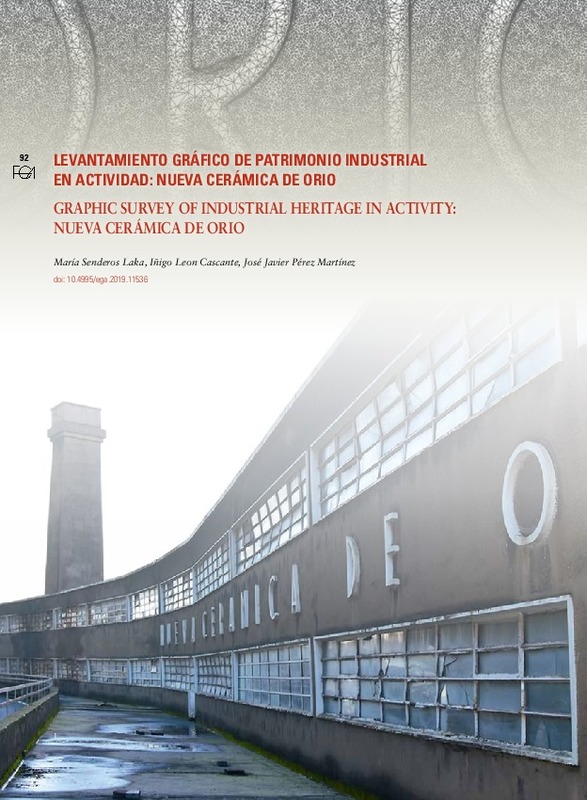JavaScript is disabled for your browser. Some features of this site may not work without it.
Buscar en RiuNet
Listar
Mi cuenta
Estadísticas
Ayuda RiuNet
Admin. UPV
Levantamiento gráfico de patrimonio industrial en actividad: Nueva Cerámica de Orio
Mostrar el registro sencillo del ítem
Ficheros en el ítem
| dc.contributor.author | Senderos Laka, María
|
es_ES |
| dc.contributor.author | León Cascante, Iñigo
|
es_ES |
| dc.contributor.author | Pérez Martínez, José Javier
|
es_ES |
| dc.coverage.spatial | east=-2.1260881350701766; north=43.279113840389016; name=Pelotari Kalea, 5A, 20810 Orio, Gipuzkoa, Espanya | es_ES |
| dc.date.accessioned | 2019-07-23T10:33:15Z | |
| dc.date.available | 2019-07-23T10:33:15Z | |
| dc.date.issued | 2019-07-22 | |
| dc.identifier.issn | 1133-6137 | |
| dc.identifier.uri | http://hdl.handle.net/10251/124018 | |
| dc.description.abstract | [EN] The purpose of this study is to emphasise the difficulty of conducting a graphic survey in an industrial architectural space, and especially when this is still in use. Faced with the need to prepare precise and rigorous graphic documentation, in a place with a high degree of spatial fragmentation and very deficient natural lighting, the application of photogrammetric techniques and laser scanning presents considerable limitations. So, complementary tools must be resorted to, and in this sense, traditional graphic surveys, using a combination of direct measurement processes, play an essential role. A description is given of the combined procedure of the different techniques used, in addition to some comparative results that permit establishing conclusions about the quality of the geometric documentation obtained. | es_ES |
| dc.description.abstract | [ES] Mediante este trabajo se quiere poner de relieve la dificultad que supone la realización de un levantamiento gráfico en un espacio arquitectónico que es industrial y además está en uso. Frente a la necesidad de elaborar una documentación gráfica de manera precisa y rigurosa, en un ámbito con un alto grado de fragmentación espacial e iluminación natural muy deficiente, la aplicación de las técnicas fotogramétricas y escaneado láser presentan limitaciones importantes. De esta manera, se hace necesario recurrir a herramientas complementarias, en las que el levantamiento gráfico tradicional, mediante el uso combinado de procesos de medición directa, juega un papel fundamental. Se describe el procedimiento combinado de las distintas técnicas empleadas y algunos resultados comparativos que permiten establecer conclusiones sobre la calidad de la documentación geométrica obtenida. | es_ES |
| dc.language | Español | es_ES |
| dc.language | Inglés | es_ES |
| dc.publisher | Universitat Politècnica de València | |
| dc.relation.ispartof | EGA. Revista de Expresión Gráfica Arquitectónica | |
| dc.rights | Reconocimiento - No comercial - Sin obra derivada (by-nc-nd) | es_ES |
| dc.subject | Levantamiento gráfico | es_ES |
| dc.subject | Fotogrametría | es_ES |
| dc.subject | Patrimonio industrial | es_ES |
| dc.subject | Nueva Cerámica de Orio | es_ES |
| dc.subject | Graphic survey | es_ES |
| dc.subject | Photogrammetry | es_ES |
| dc.subject | Industrial heritage | es_ES |
| dc.title | Levantamiento gráfico de patrimonio industrial en actividad: Nueva Cerámica de Orio | es_ES |
| dc.title.alternative | Graphic survey of industrial heritage in activity: Nueva Cerámica de Orio | es_ES |
| dc.type | Artículo | es_ES |
| dc.date.updated | 2019-07-23T07:53:40Z | |
| dc.identifier.doi | 10.4995/ega.2019.11536 | |
| dc.rights.accessRights | Abierto | es_ES |
| dc.description.bibliographicCitation | Senderos Laka, M.; León Cascante, I.; Pérez Martínez, JJ. (2019). Levantamiento gráfico de patrimonio industrial en actividad: Nueva Cerámica de Orio. EGA. Revista de Expresión Gráfica Arquitectónica. 24(36):92-105. https://doi.org/10.4995/ega.2019.11536 | es_ES |
| dc.description.accrualMethod | SWORD | es_ES |
| dc.relation.publisherversion | https://doi.org/10.4995/ega.2019.11536 | es_ES |
| dc.description.upvformatpinicio | 92 | es_ES |
| dc.description.upvformatpfin | 105 | es_ES |
| dc.type.version | info:eu-repo/semantics/publishedVersion | es_ES |
| dc.description.volume | 24 | |
| dc.description.issue | 36 | |
| dc.identifier.eissn | 2254-6103 |








